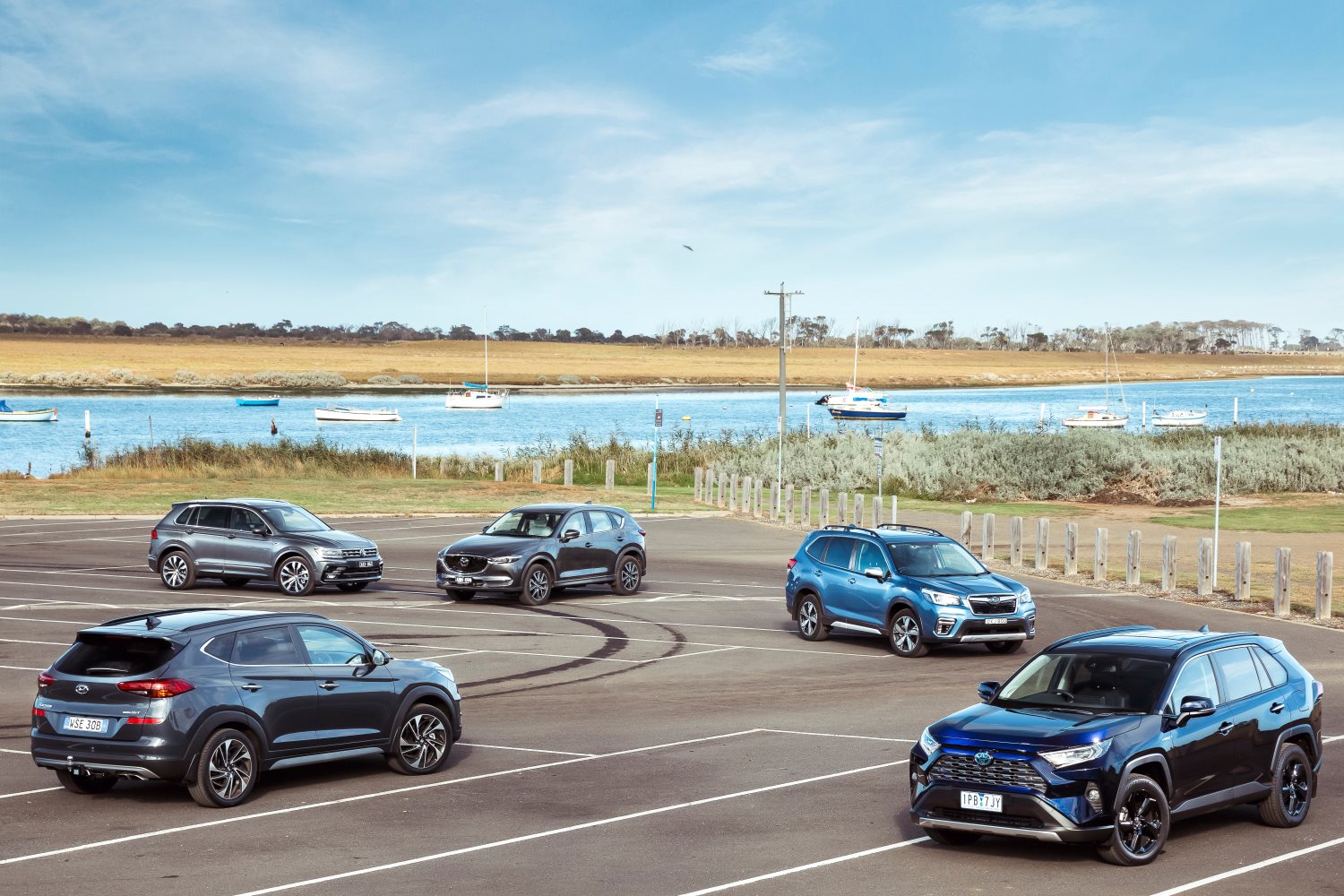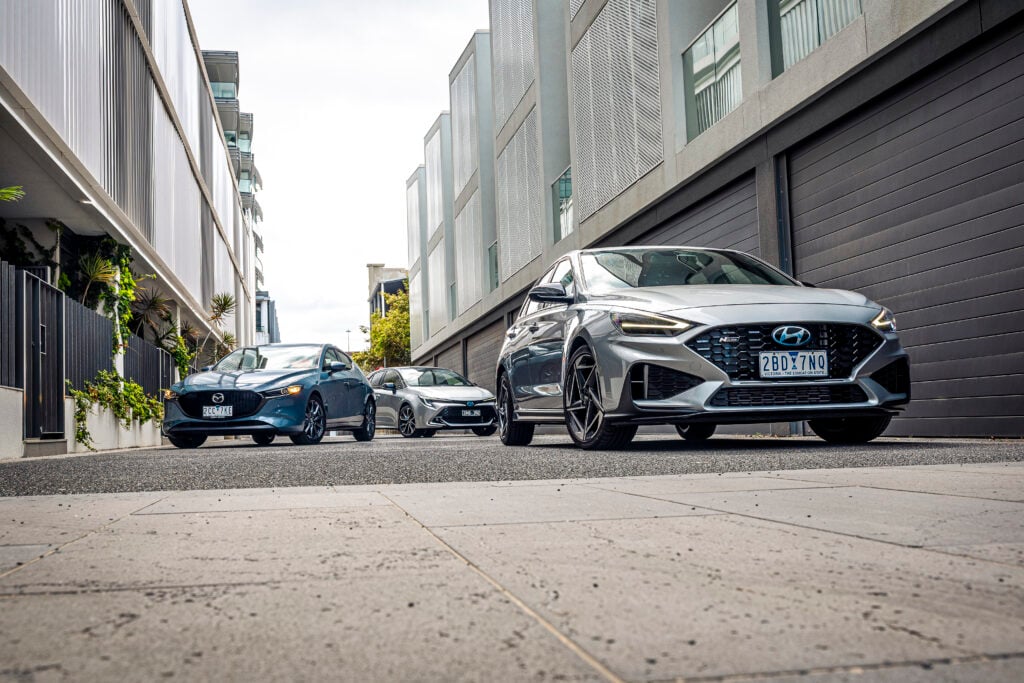They say slow and steady wins the race. If that’s the case, Toyota is playing a very long game. For several decades from the 1960s, the Japanese manufacturer helped improve the car as we know it (and the company’s bottom line) through better manufacturing, quality, reliability and value. But as for Ford Model T/Morris Mini/Volkswagen Golf-level game-changers? No dice. It was all about evolution rather than revolution.
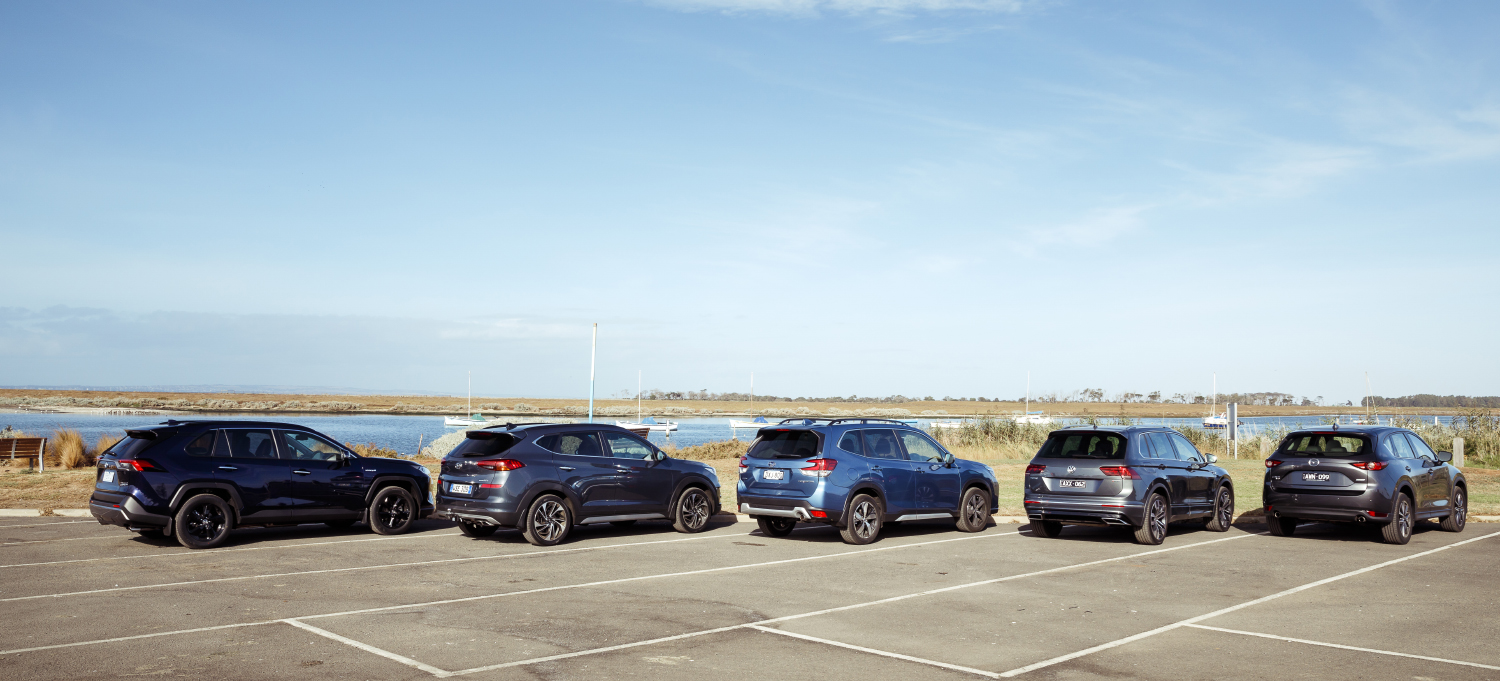
Then, in the space of three years, Toyota changed the way we drive forever. Twice.
First up was 1994’s RAV4. Sure, like a motoring version of Madonna, inspiration from elsewhere played a role courtesy of Suzuki’s original Vitara of six years earlier. But the genius lay in the execution – similar adventurous styling to the latter, but in place of a cumbersome off-road chassis, Toyota instead jacked up the Corolla platform, raided the Camry/Celica running gear cupboard and fashioned a LandCruiser-lite cabin. Upshot? Nothing less than the invention of the modern SUV. It took just two decades to achieve global domination and sales are still surging.
Speaking of surging, Toyota’s second revolution, of course, was the petrol-electric Prius of 1997, ushering in the hybrid. Now the company has combined its trailblazers in the consumer-baiting form of the all-new RAV4 hybrid. Even the Avengers would think twice before tackling this juggernaut.
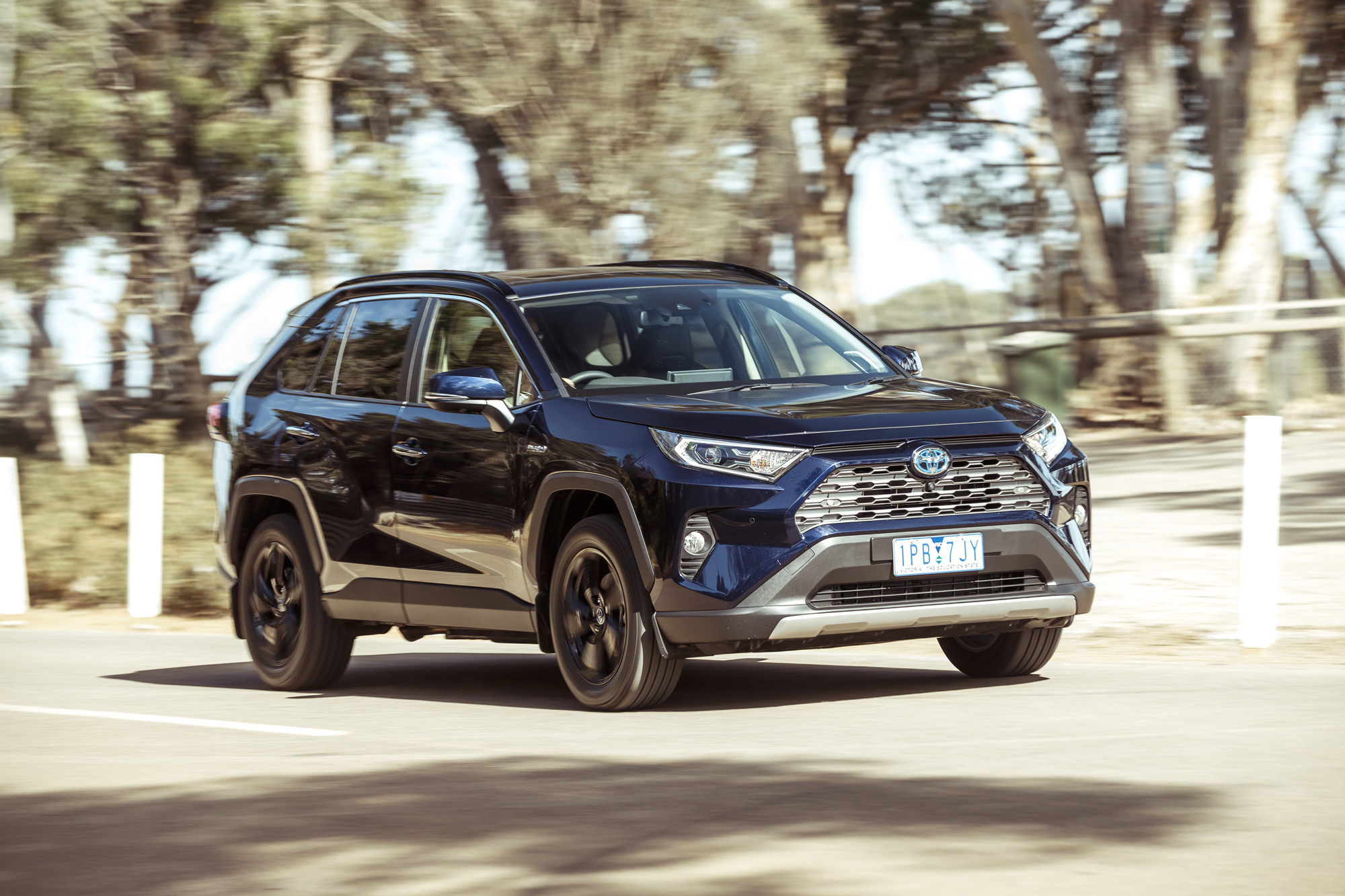
Hello, new Rav4
Now in its fifth generation, the latest RAV4 is the second model after the Camry to switch to the snappily titled ‘Toyota New Global Architecture K-platform’. The key points are improved centre of gravity brought on by lower seating and engine placement, wider tracks, a lighter yet stronger body and more rigidly mounted steering and suspension. Dramatically better dynamics, comfort, refinement and noise suppression are the goals.
TNGA-K couldn’t come soon enough. Though a top-three segment stalwart, the previous RAV4 released in 2013 essentially dated back to 2006, and was off the pace in all these areas and more. Did Toyota’s reputation and plain consumer laziness alone keep the old dullard selling? Who could say?
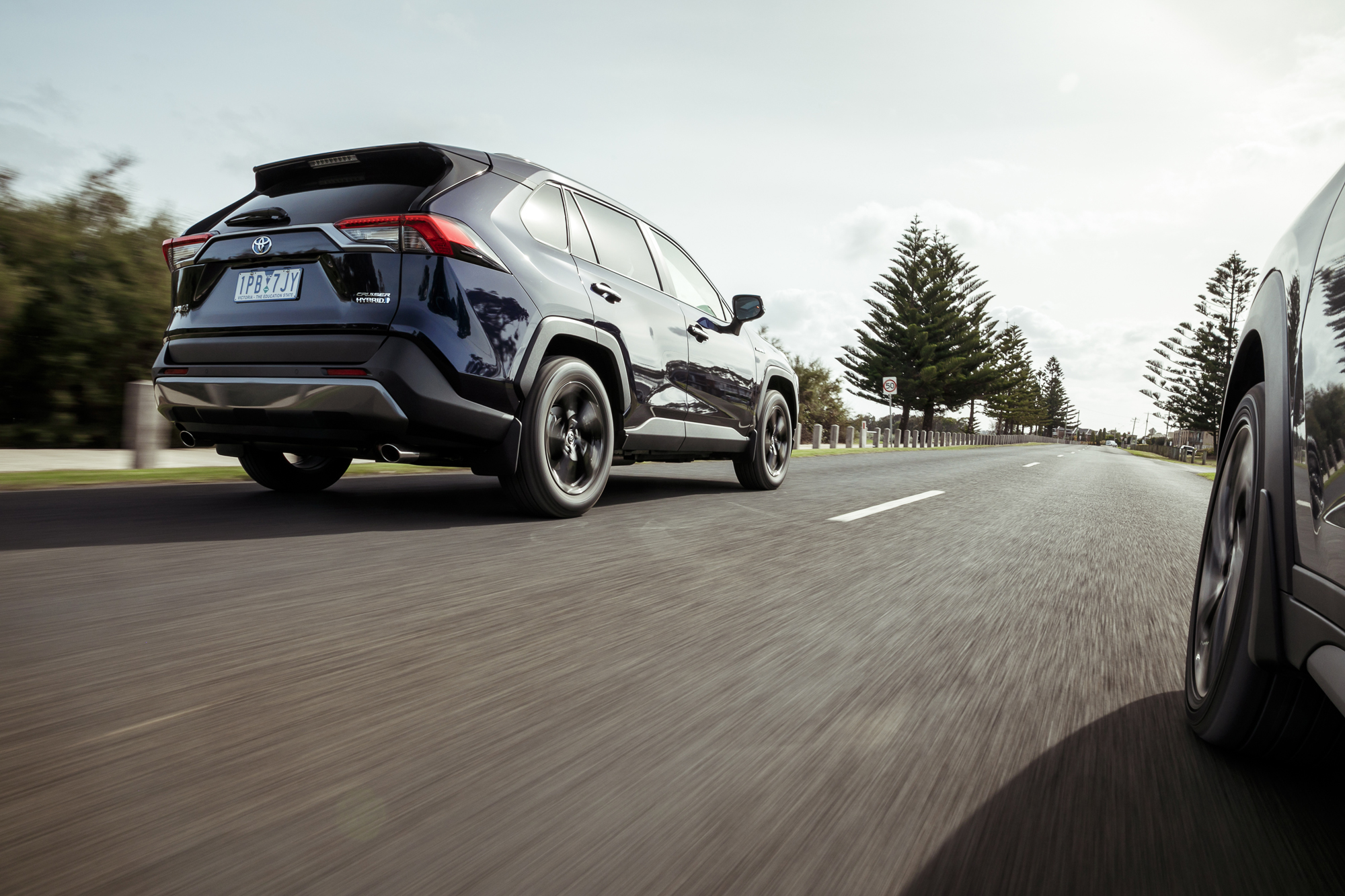
Today’s box-fresh Cruiser Hybrid e-AWD flagship starts from $44,640. The previous diesel equivalent cracked $50K. Equipment levels improve too, with autonomous emergency braking, lane-departure warning with steering assist, traffic- sign recognition, rear cross-traffic alert/braking, adaptive cruise control, auto high beam, configurable instrumentation, sunroof, premium audio, powered driver’s seat with memory, heated front seats, surround-view camera, climate control, wireless charging, DAB radio, powered tailgate and 18-inch alloys. Note some typical Toyota AWOL spec anomalies, though, namely no Apple CarPlay/Android Auto and front passenger-seat height adjustment – a potential pain in the neck for lankier folk.
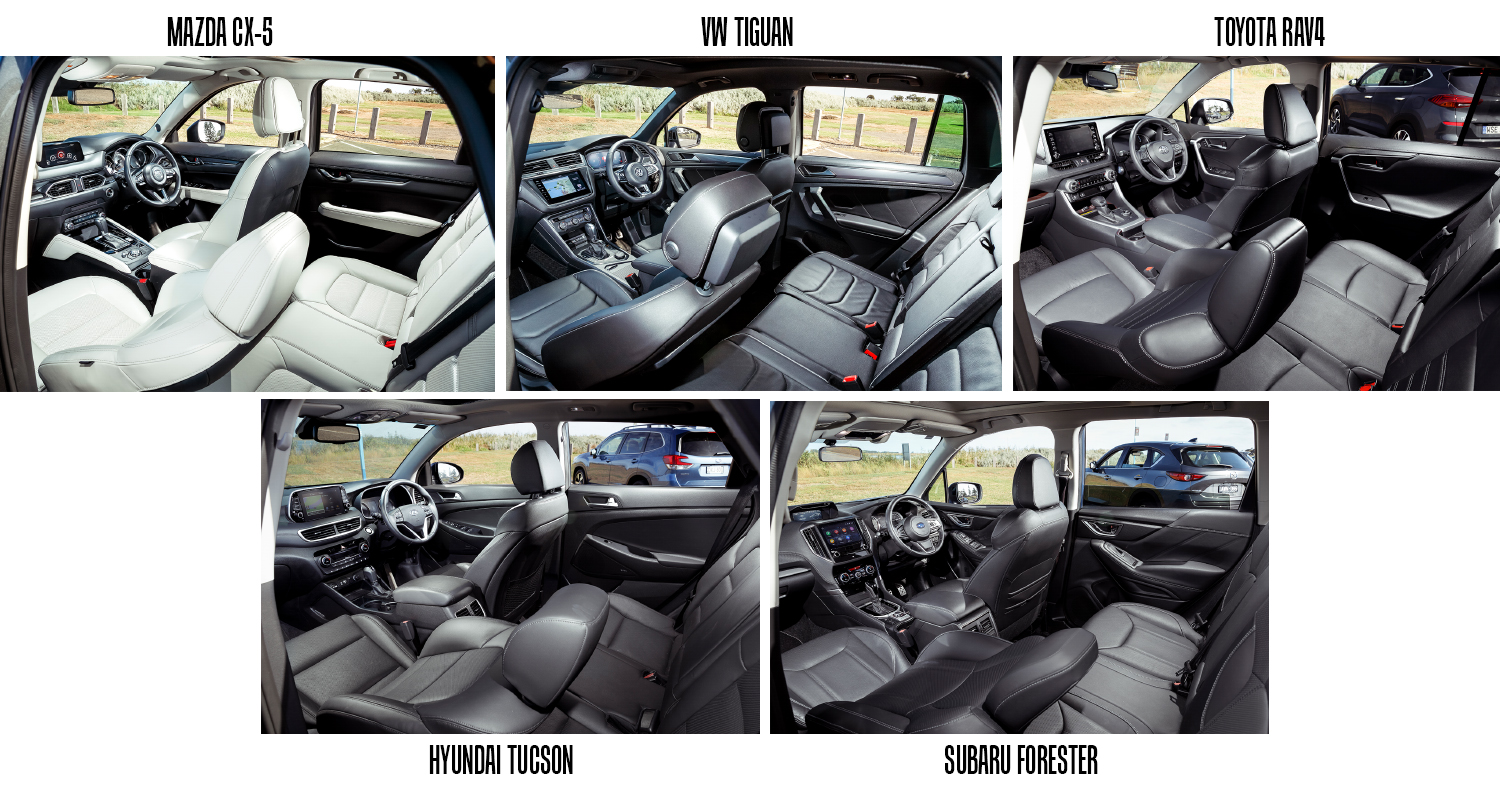
The hybrid powertrain consists of a naturally aspirated 131kW/221Nm 2.5-litre four-cylinder Atkinson-cycle petrol/CVT combo assisted by an 88kW electric motor on the back axle solely providing torque to the rear and/or assisting the front wheels, as required.
As it’s the most powerful (and intriguing) on offer for now, we’re pitching the Cruiser Hybrid against four of its better higher-grade AWD adversaries – the bestseller (Mazda CX-5), our current class favourite (Subaru Forester), the segment social climber (Volkswagen Tiguan) and the most recently facelifted (Hyundai Tucson).
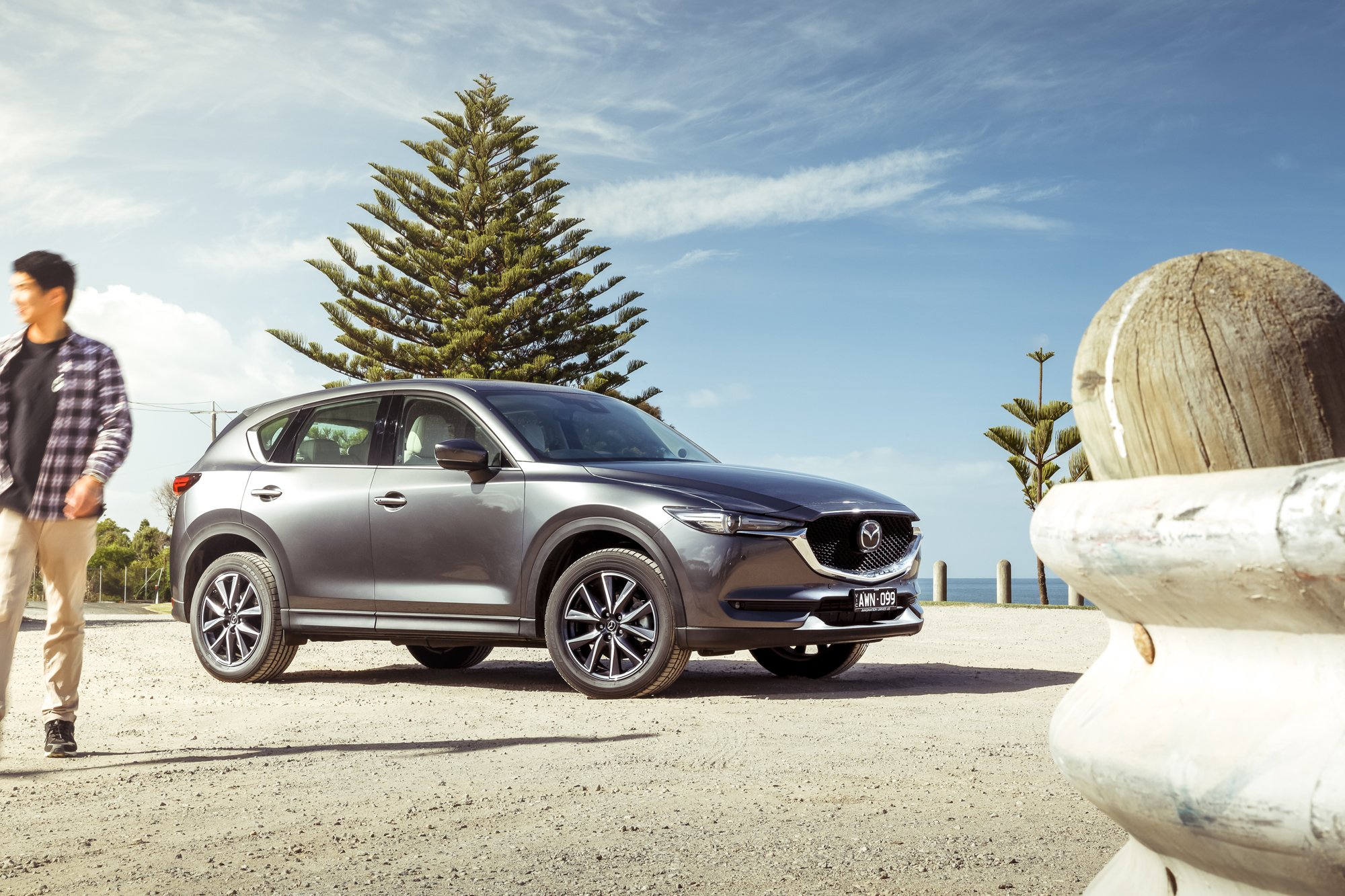
The rivals
Newly armed with a 170kW/420Nm, 2.5-litre four-cylinder turbo-petrol heart/six-speed torque-converter auto transplant from our COTY-winning CX-9, the $47,890 CX-5 GT Turbo introduces more muscle for the two-year-old second-gen KF series, but sadly for some, there’s squat visual differentiation for the neighbours to notice. Equipment benefits over the RAV4 include a head-up display, adaptive LED headlights and 19-inch alloys – but the lack of a surround-view camera is a bad miss.
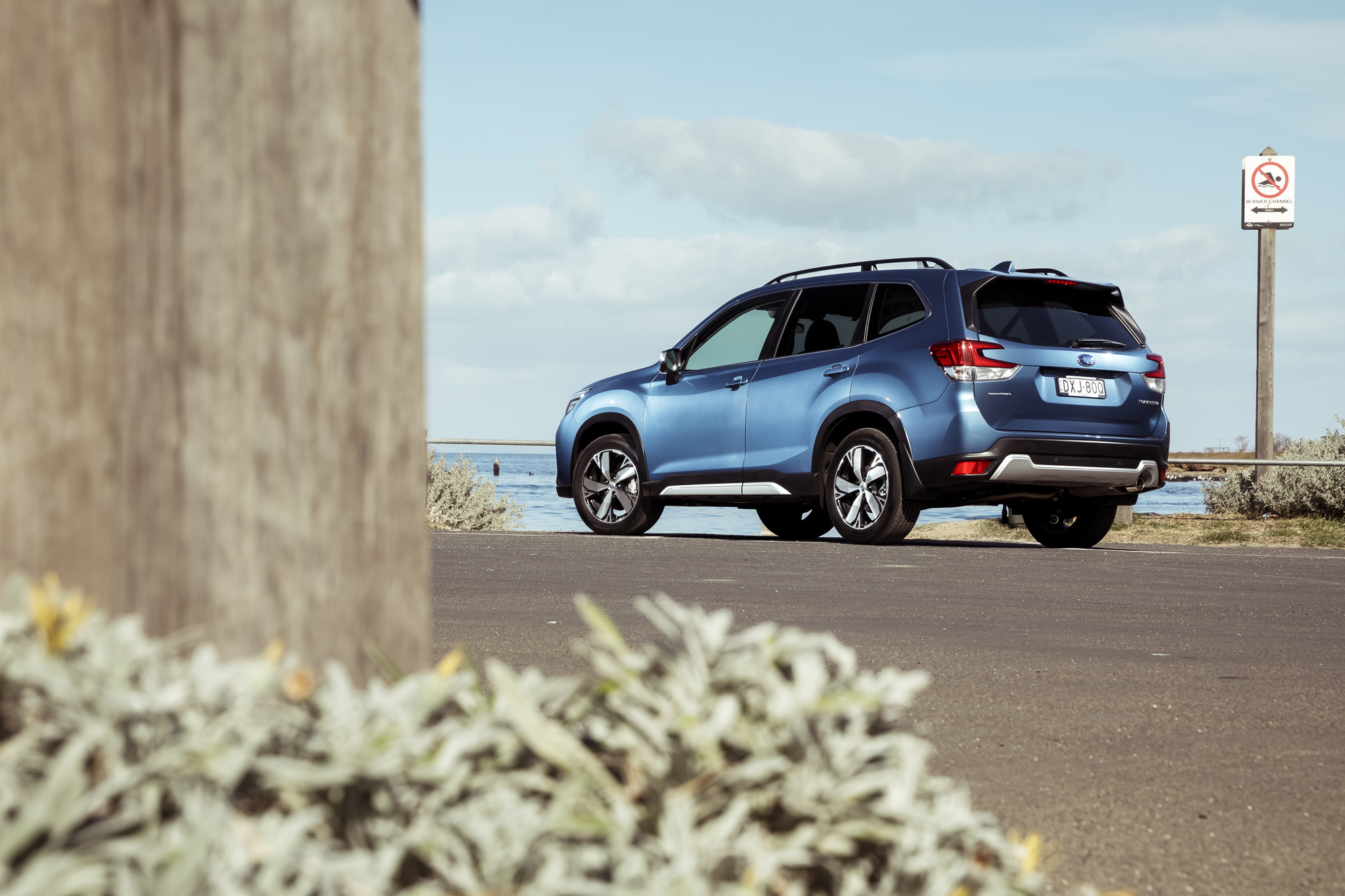
The most expensive version of the fifth-iteration Forester is still the cheapest car here – the $41,490 2.5i-S. New last year, our third Japanese contender also brings the lowest torque on test from its 2.5-litre atmo boxer/CVT powertrain (136kW/239Nm). Yet that didn’t stop it scoring a clear victory against the lower-spec CX-5 Touring, Ford Escape ST-Line and Tiguan 132TSI Comfortline (see Wheels November 2018), so the smart money is on the Subaru. There’s heaps in it, too. Along with much of the aforementioned, it introduces facial recognition tech that memorises individual driving-position settings and also signals when the driver’s eyes stray from the road ahead via a shaming alert. Big Brother much? Don’t expect a bum heater, though.
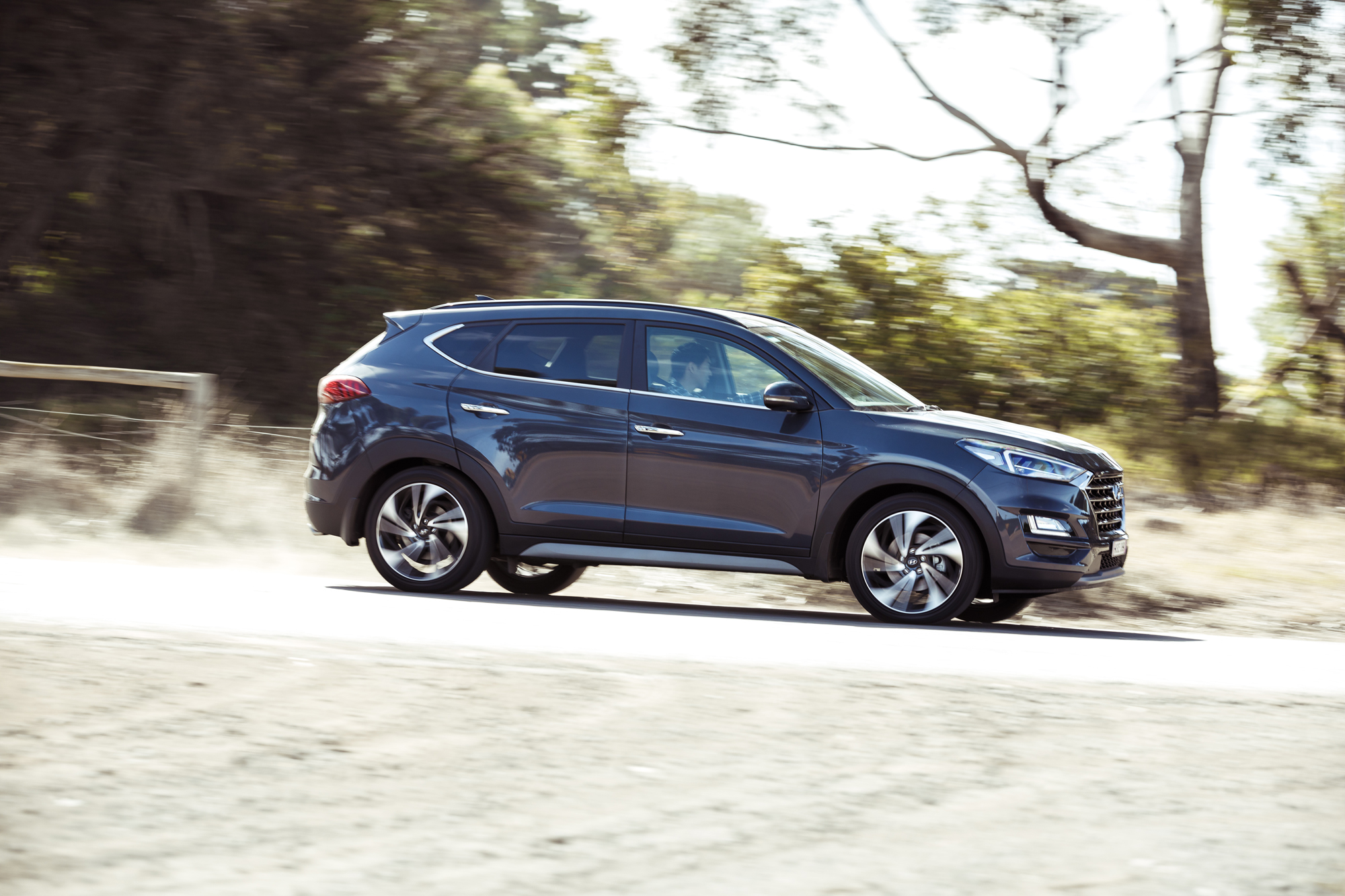
Facelifted after three years in mid-2018 with a nose job, dash makeover featuring a free-standing touchscreen, uprated safety and updated multimedia, the popular Mk3 Tucson in TL Series II Highlander Turbo AWD format meets its opponents for features and then throws down a vast panoramic sunroof, heated steering wheel and cooled front seating gauntlet, all from $46,500. Where the SUV from South Korea falls short is in power – 130kW and 265Nm from 1.6 hard-working turbocharged litres and a seven-speed dual-clutch trannie.
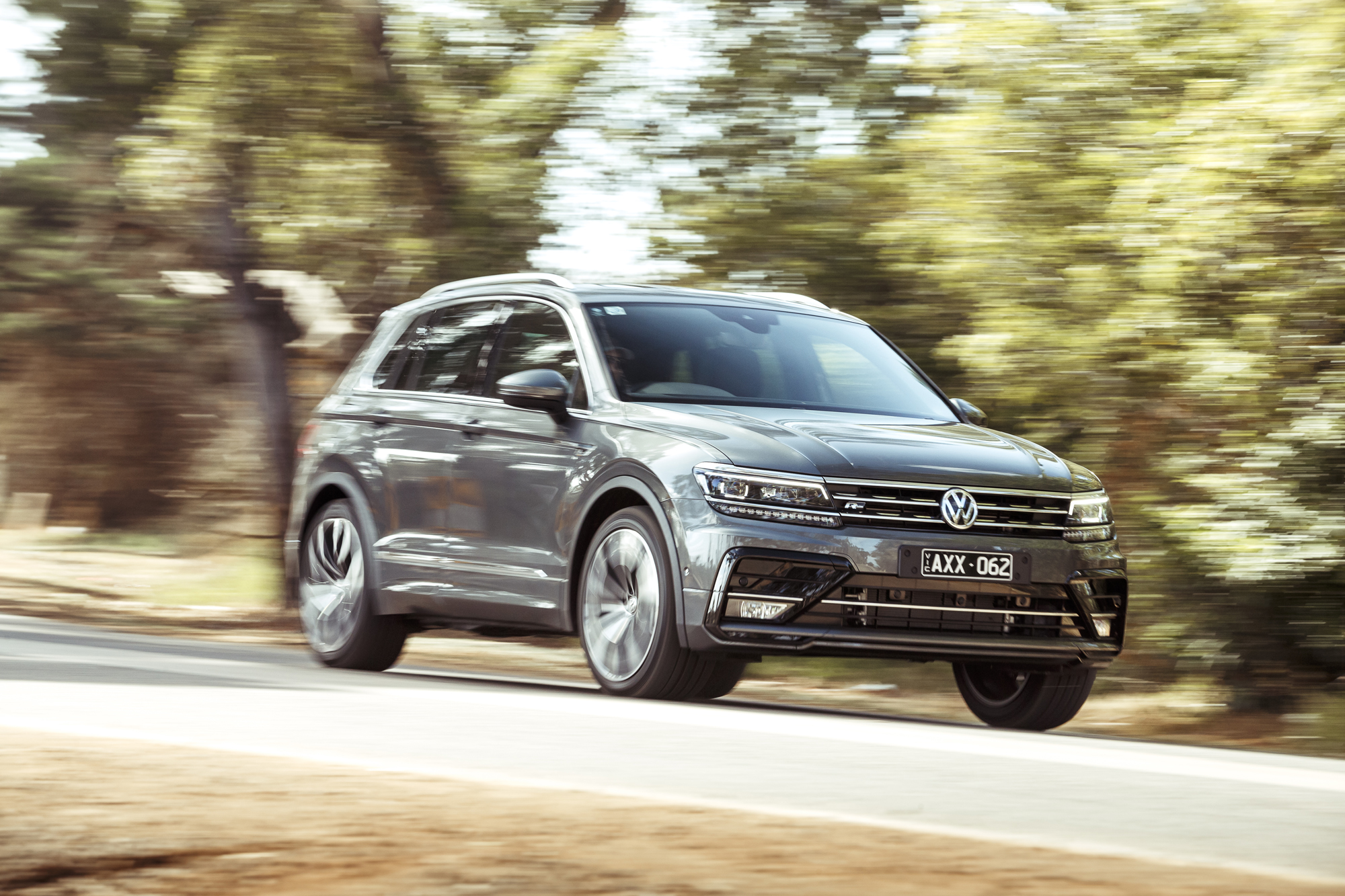
The opposite applies with the Tiguan. Shoehorning the Golf GTI’s 162kW/350Nm 2.0-litre turbo and seven-speed DCT to create the 162TSI Highline 4Motion conjures up tantalising notions of a mid-sized SUV/hot-hatch mash-up, helping justify the 2016-vintage German’s premium $50,150 pricing. Startlingly, it’s also the fastest-selling grade. Ours heaved with extras (racy R-Design kit inside and out, tech-rich Sound/Vision pack, giant sunroof, 20-inch alloys), bumping it up to nearly $59K. And that’s without a DAB+ radio. Still, with the quintet’s only standard adaptive dampers and configurable chassis, as well as a sliding rear seat, airline-style back-seat trays, 12V outlet and 40/20/40-splitting backrest for added versatility, we’re talking business-class travel.
Fun for all the family
Brandishing remarkably similar dimensions if not designs, all five medium SUVs pass muster as roomy four seaters with an adult-tolerable rear-middle fifth position as required, while also boasting unfettered entry/egress, a fairly sizeable cargo area and the minimum-requirement cupholder and USB ports the modern family demands.
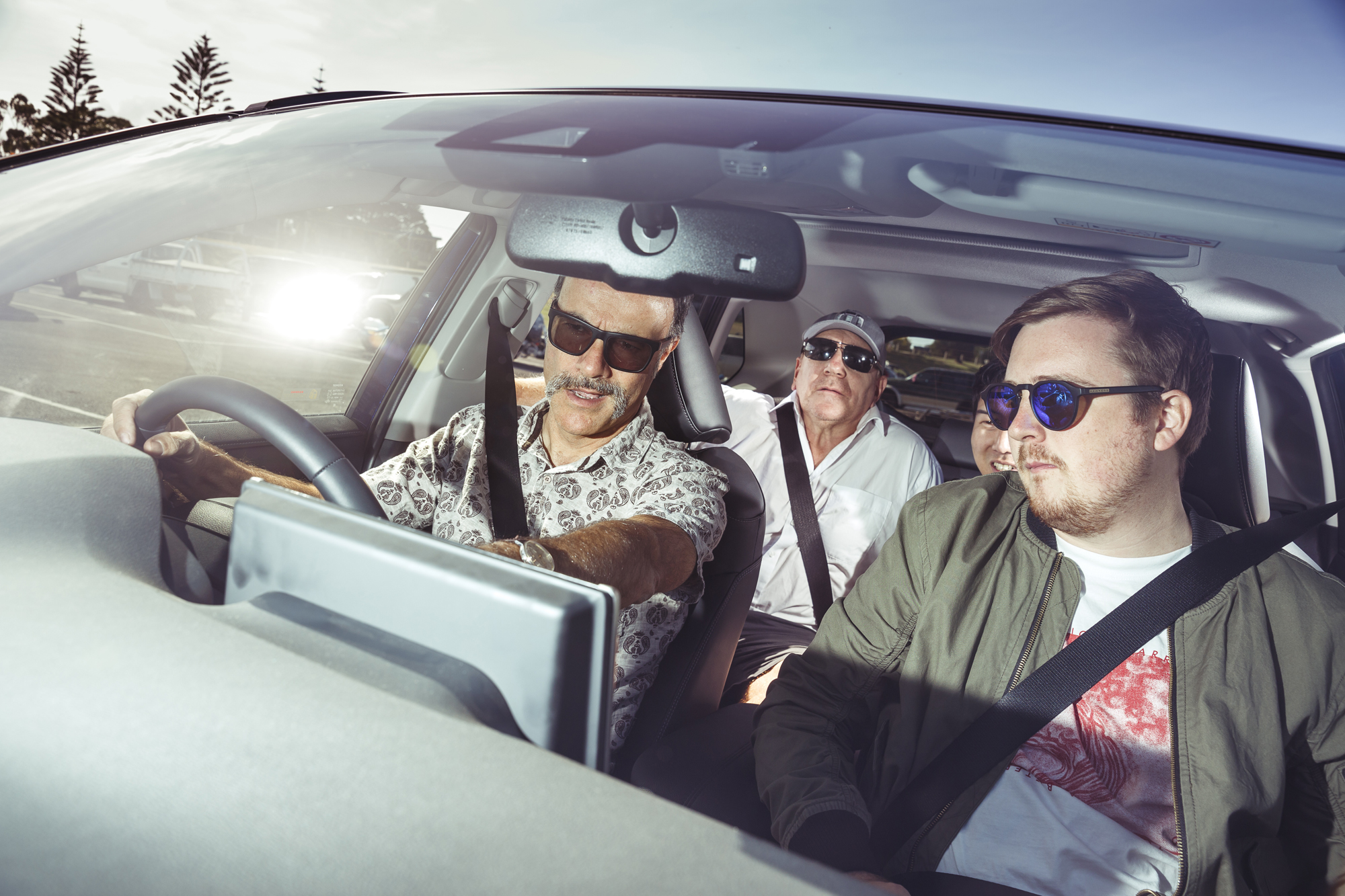
If you’re familiar with the previous RAV4, you’ll recognise the latest Cruiser as a Toyota, but one that’s trying much harder than before. Cheap and cheerless utilitarianism gives way to interesting design and appealing textures that don’t come at the expense of functionality. A real feeling of space, enveloping front seats, pleasing materials, good all-round vision and significantly better refinement represent huge strides for the nameplate, though the central screen’s chintzy little buttons and flair-free graphics may annoy some. And best try before you buy if you’re on the tall side, because the sunroof eats headroom. No remote rear-seat release is a bit mean, too.
If the expansive RAV4 conveys stylish yet practical IKEA-esque modernity then the cosy (though never cramped) CX-5 GT is a triumph of determined self-improvement. Five years ago, we called out the original KE as an SUV of two halves due to a cold, droney and miserable rear cabin undermining Mazda’s great work elsewhere. Nowadays, sumptuous seating, a sporty driving position, thoughtful ergonomics, delightfully tactile switchgear and pleasing consistency define a higher-quality cabin experience than anticipated. Yes, the small-ish central tablet looks a bit clunky, there’s no inductive charging pad and there’s still outside noise intrusion, so some wrinkles are beginning to show, but even a brief stay inside highlights why sales remain so buoyant.
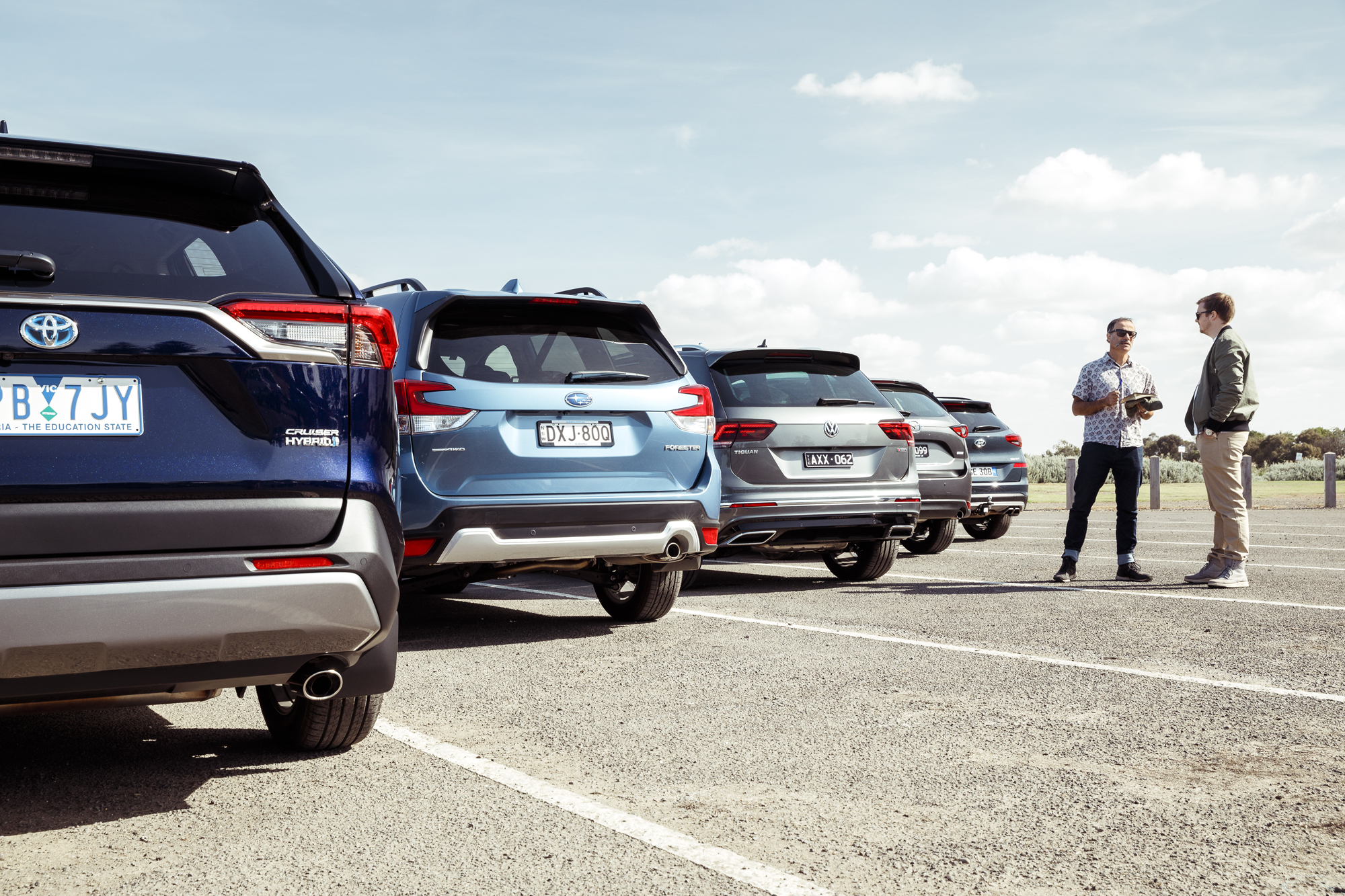
Still, if feeling rich is your deepest desire, then the Tiguan’s appropriately titled Highline R-Line with Sound/Vision package will oblige, offering multiscreen digital instruments and a gorgeously slick multimedia interface to go with the spacious surroundings. Deep windows and that vast sunroof also boost the already opulent cabin ambience, while beautiful, bolstered seating and considered surfacing further elevate the posh Vee Dub’s station in life. You might struggle to find a more capacious cargo area as well. That said, wind noise is an issue, the scaled-up cookie-cutter Golf-aping dashboard architecture is now dated, the rear backrests are too firm, and are seven cupholders encouraging obesity?
The Tucson earns admiration with an on-brand cabin that hardly puts a foot wrong, with ample space, comfy seating and abundant storage. It’s an easy vehicle to come to grips with quickly. Perfect rental fodder. But, aside from the overhead glazing, there’s nothing about the Highlander that suggests flagship, particularly with some obvious hard and scratchy plastics in the second row, while comparatively high road noise and lack of bump absorption means occupants are more likely to be shaken than stirred. Here more than anywhere else the Hyundai is showing its age. As one tester noted, this feels $10K cheaper than the others.
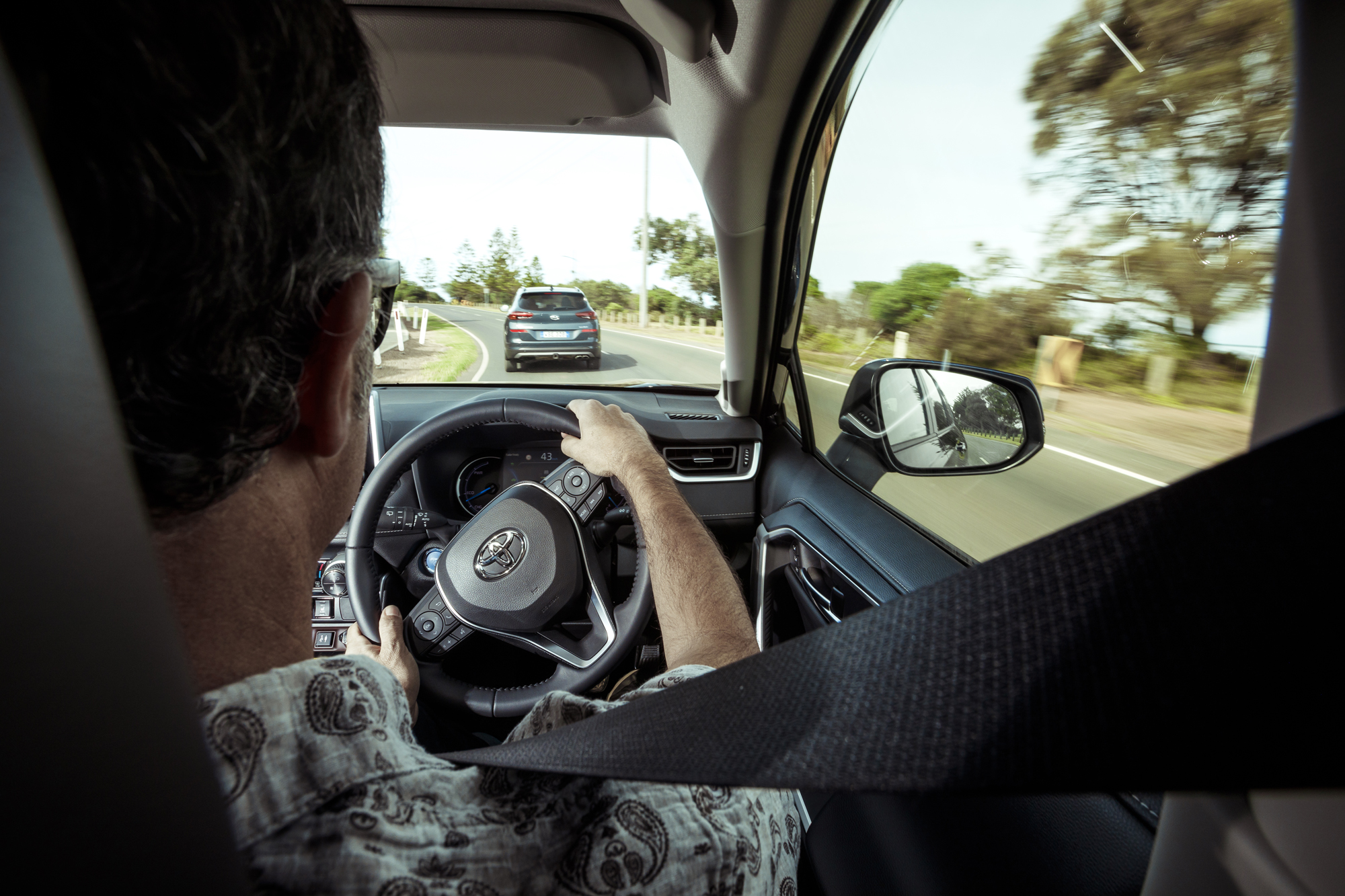
Today’s Forester, on the other hand, seems to exist outside accepted pricing, positioning and fashion parameters, transcending these to deliver a unique user experience. Larger, longer and wider than preceding generations, the latest version truly, madly and deeply feels designed from the inside out, acing its opponents for space, comfort, functionality and vision. The latter is extraordinary, actually, adding an almost unimpeded and confidence-enhancing dimension to driving. Seating and suspension are tuned to cosset and isolate. Controls are reached without stretching or straining, while items can be secured within reach. Dumpy and heavy-handed the design may be, with busy touchscreens bombarding you with data you may wish to ignore, but otherwise the Forester is also endearingly warm and accommodating. Outstanding engineering. Too bad its face looks like a koala.
Time to hustle
There’s an old adage about a brilliantly sorted chassis always being able to cope with a lot more power, and that applies to the Subaru. In isolation, the Forester’s FB25 boxer feels eager off the mark and spirited in the ease with which it gains speed, with the CVT working away unobtrusively in everyday traffic. In normal ‘Intelligent’ mode the performance on offer is more than sufficient, while selecting ‘Sport’ adds a discernible frisson of urgency.
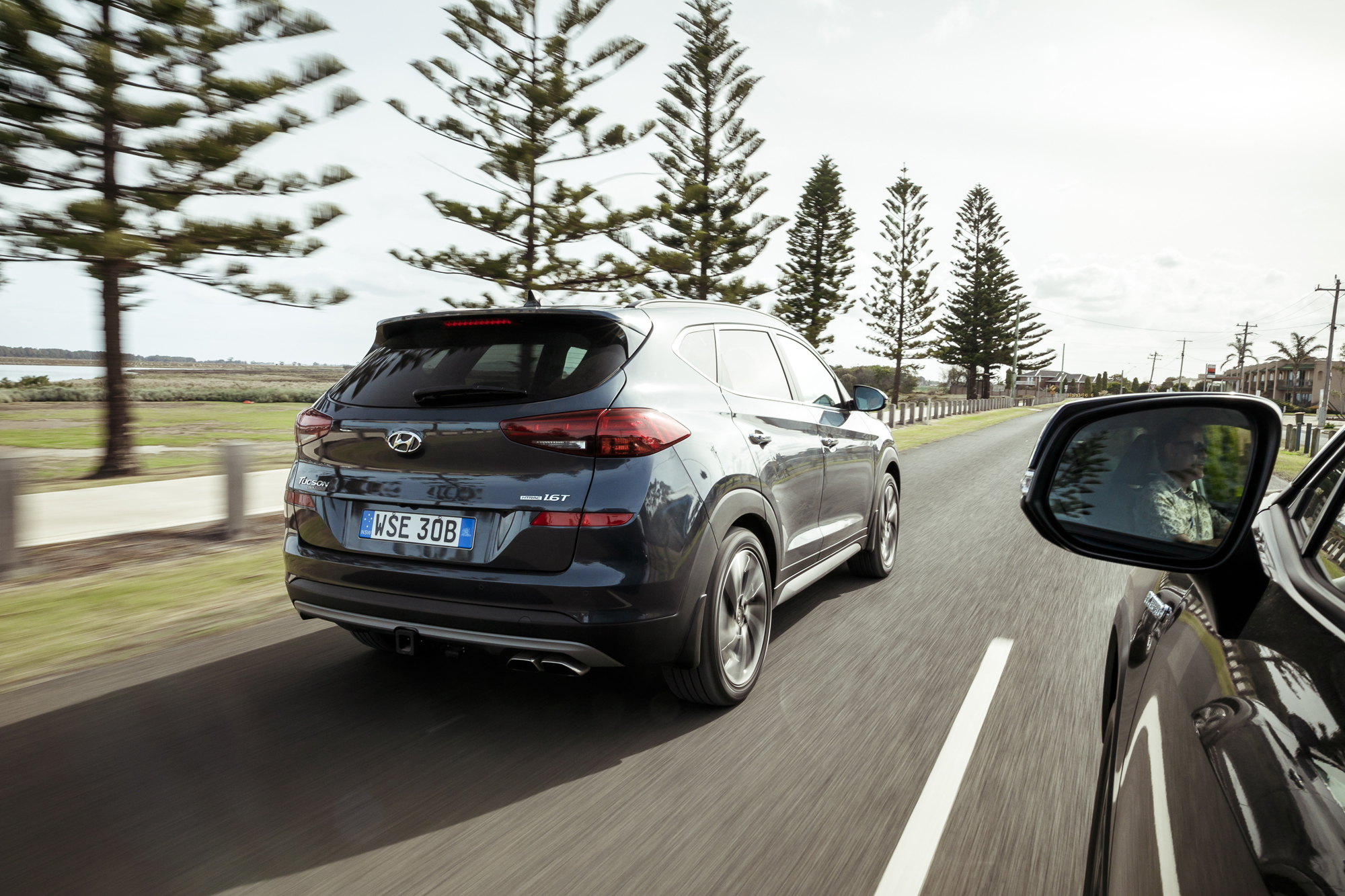
In the company of its turbo and electrically assisted foes, however, the Forester struggles to keep up, unable to crack nine seconds to 100km/h and lagging behind the rest across most increments. It does beat the smaller-capacity Tucson by 0.1sec between 80-120km/h though, proving there is no substitute for cubic inches. Planting the throttle also elicits a tiresome drone as the CVT digs its heels in. What the 2.5i-S’ engine needs is a big fat turbine. At least it’s the least thirsty out of the non-hybrids, so there is some consolation.
The Hyundai, on the other hand, has a hard time on both counts. An 8.4sec result racing to 100 is actually respectable, with the DCT plucking the appropriate ratios with inconspicuous ease. The lack of lag and very natural feel of it means you’d be hard-pressed to pick it as a dual-clutch gearbox. However, the 1.6 turbo has to be in its sweet spot to really sing, and with that come levels of mechanical clamour unwelcome to those seeking silence. And the numbers don’t lie; once in triple-digit speeds, there just isn’t the oomph on tap and the Hyundai starts to run out of steam sooner than later. Plus, there’s a price to pay at the petrol pump, with the Highlander proving to be the thirstiest on test at 12.3L/100km.
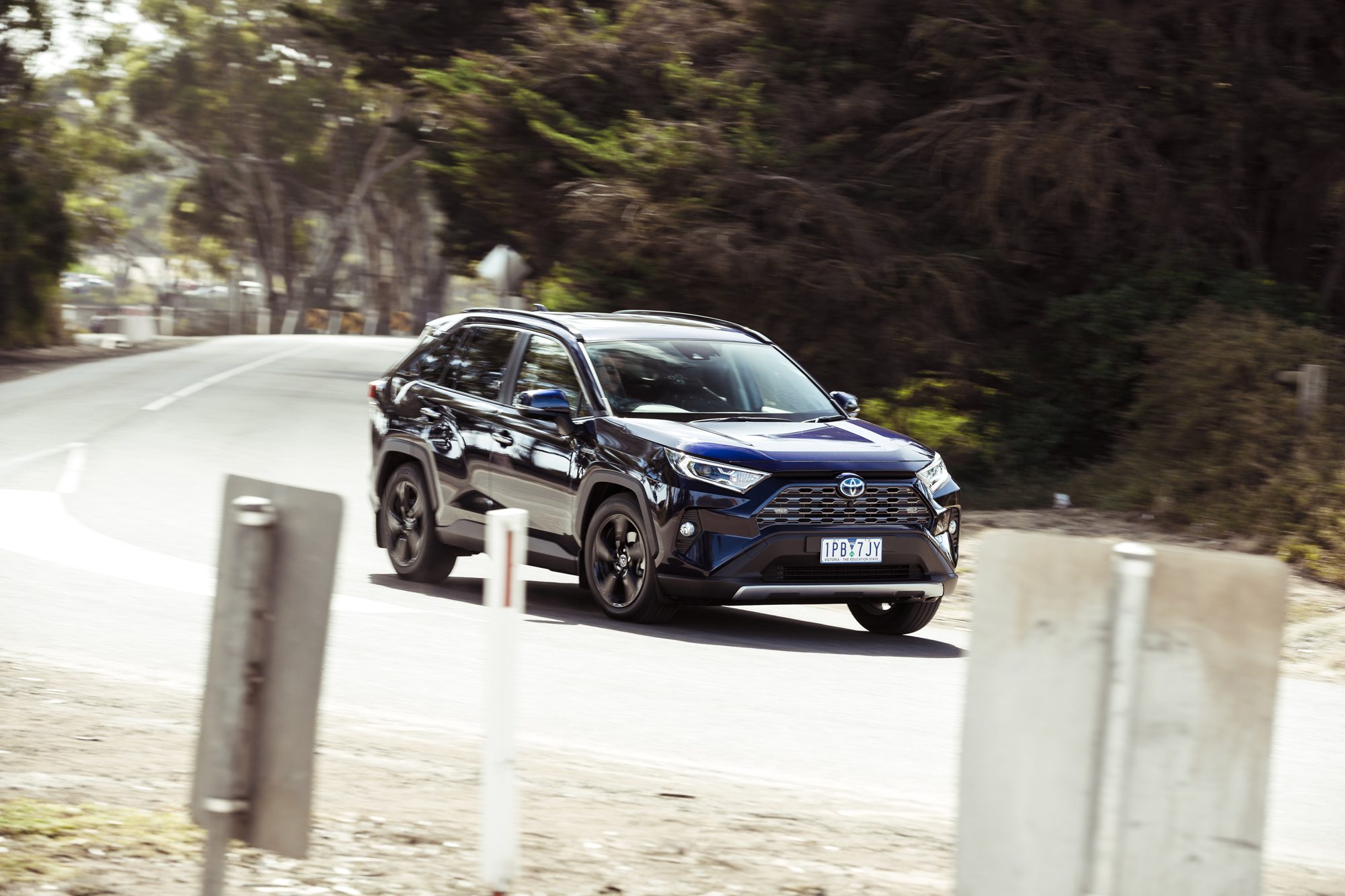
The group’s heavyweight at 1745kg, the portly Toyota’s party trick is its groundswell performance delivery that brings a deep, velvety well of mid-range torque for punchy overtaking abilities while returning a headline economy figure of just 8.7L/100km. Also armed with a CVT, it isn’t especially musical as the engine’s revs rise, bellowing out a thrashy rebel yell if you’re feeling particularly punky, but there’s speed on tap to savour. While 8.0sec to 100 is barely half a second better than the Hyundai, a 5.2sec 80-120 catapults the hard-charging 221Nm RAV4 into the 420Nm CX-5 turbo sphere, with vigour to spare. The hybrid/CVT combo feels ready and robust, rarely if ever getting caught out by terrain or driver inattentiveness.

Then there’s the Mazda, which delivered slightly muted performance given its engine spec. While measurably brisker than its atmo sibling, the 2.5 turbo’s 7.5sec best to 100 is substantially adrift of the less torquey Tiguan, which blitzed through in a sizzling 6.6sec. The numbers reveal a turbo that’s more about boosting the GT’s mid-range muscle than pinning occupants into their seatbacks at a touch of the throttle. Tipping the scales at just 10kg less than the Toyota hybrid as well as having only six speeds might also explain the CX-5’s voracious appetite for unleaded – 11.9L/100km versus a reasonable 10.7L for the 83kg-lighter Volkswagen. Note, however, that the Hiroshima SUV is the only auto on test with a forward-down tip-shift pattern, reflecting its driver focus.
On that subject, one-time Golf GTI owners craving to put fun back into functionality may finally have something to put their growing families in. Sweet-sounding and punchy across the whole rev range – and especially so with the Sport setting switched on – the 162TSI’s powertrain provides the group’s hot-rod sensation right from the onset, as revealed by further feverish performance figures: 80-120 in just 4.6sec, 14.9sec to 400 metres compared to the Mazda, next best at 15.5sec. That’s with barely 900km on the odo against the Mazda’s 4600km. And the Volkswagen ought to only improve with age.
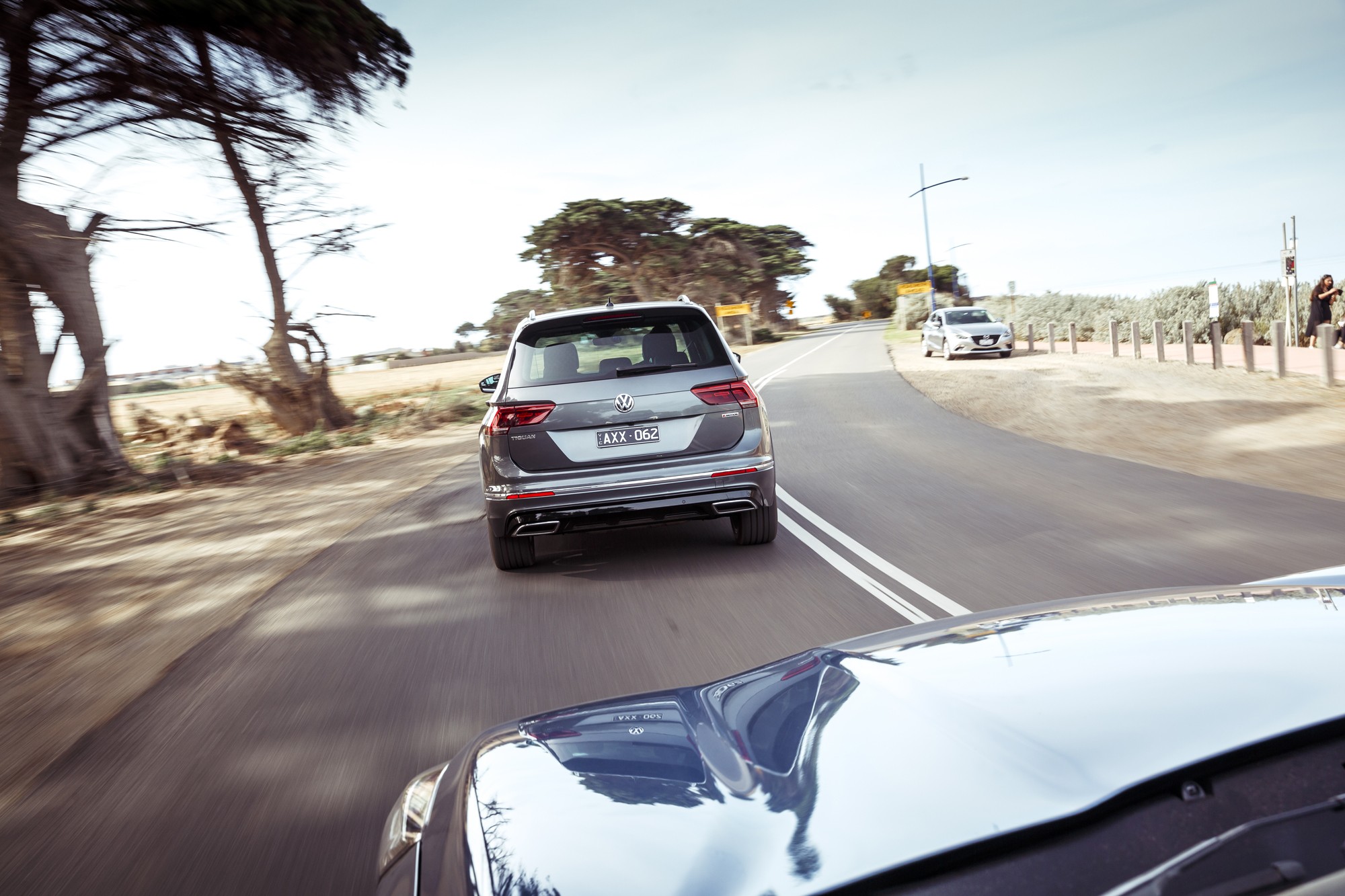
The big question is, though, is the 162TSI essentially a Tiguan GTI? Sadly, no, because in Wolfsburg’s case, even with adaptive dampers and a sport chassis tune, there isn’t the dynamic deftness to gel with all that power. On the positive side, the variable steering is promisingly sharp at lower speeds, and grip over the dry, hilly roads we raced across is prodigious. Beyond that, though, there’s just too much body lean and understeer for fast, fluid handling fun. Press on and the helm feels distant and inert, too.
At least the adaptive dampers largely compensate for the 20-inch alloys, with impressive bump (and reasonable noise) suppression. However, an underlying stiffness remains, prevalent over smaller-frequency irregularities. You’d never call the 162TSI’s suspension supple. Except, perhaps, compared to the Tucson.
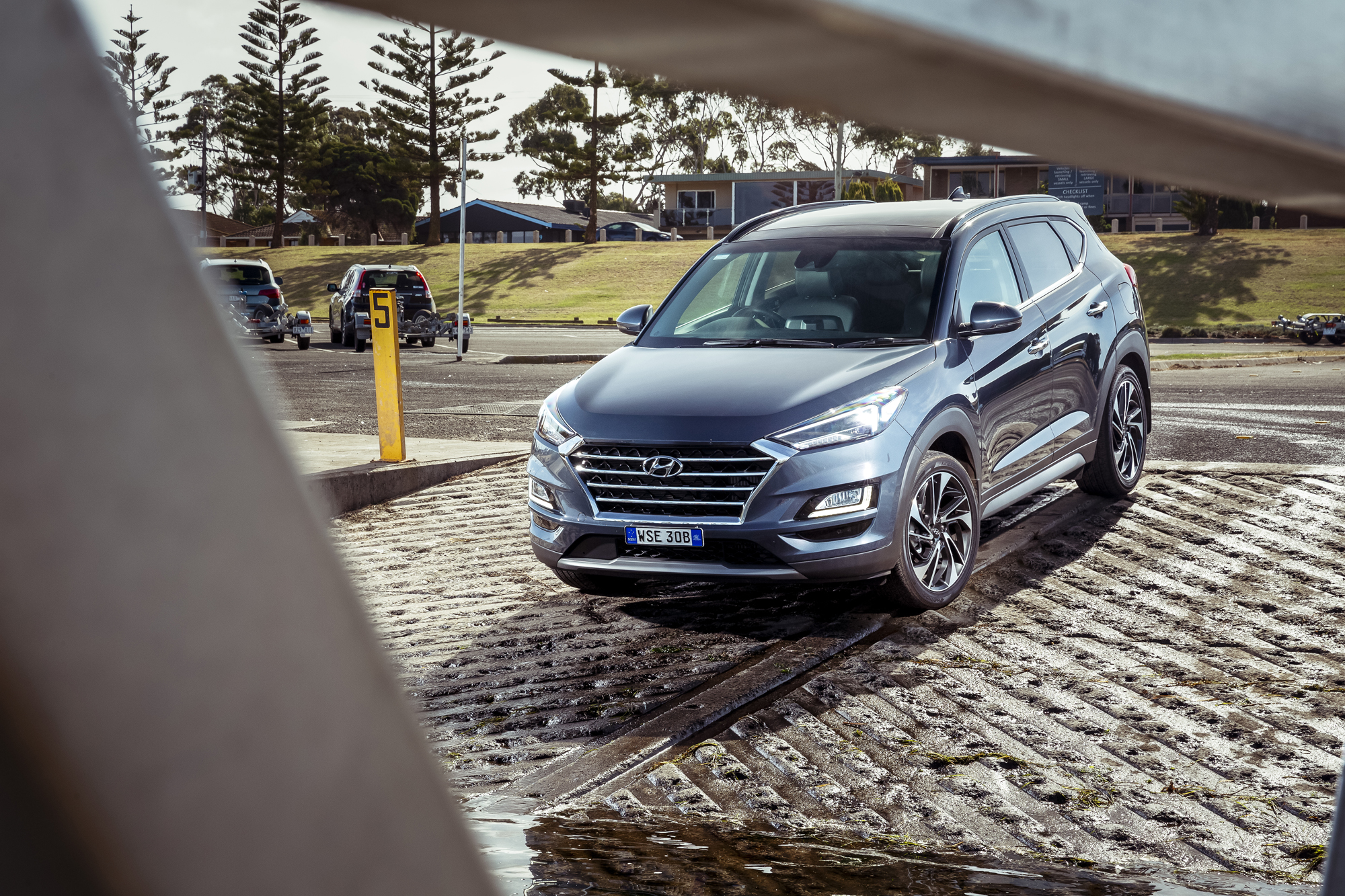
Hyundai, like Kia, loves to remind the media of the substantial Aussie tuning carried out, and subsequently the Highlander delivers decisive steering responses for confident and controlled handling. On a smooth ribbon of blacktop, the whole chassis gels together with pleasing fluency and focus. It can be a real hoot if you’re in the mood for a hoon. Maybe a name change to Torino might be more appropriate. But rougher patches reveal a firm, jittery ride, with lateral pitching and plenty of patter transmitting through to upset the serenity.
The very opposite set of characteristics define the CX-5. Quieter, more comfortable and more contained, the Mazda deals with the bad stuff underneath with a firm yet calming hand that only trembles over really chatty surfaces. But the steering is neither weighty nor talkative enough, and that’s an issue given it’s also unexpectedly reactive. The outcome is a nervous feel at speed. Fast, flowing cornering isn’t always achievable as two bites at the wheel may be necessary. There isn’t that nice four-square progression into roll through faster turns that the Subaru seems to naturally deliver.

If comfort and control are paramount, seek out a Forester. The body likes to lean, but the handling is viceless and roadholding unshakable; and while the steering could provide a bit more feedback, unflappable relaxation is the name of the game here – helped out in no small way by the confidence-enhancing vision out. And nothing came close to the Subaru’s almost supernatural ability to soak up bumps. It finds its own pace and rewards the driver regardless of speed or load.
So where does this leave the RAV4? It’s as if Toyota studied and learned from the trials and tribulations of others, resulting in steering that’s nicely weighted and responsive; agile and precise handling; and confident, faithful roadholding. And while not quite as plush as the Forester’s, the ride quality remains remarkably isolated and controlled. Only the occasionally grabby brakes – a long-time hybrid foible – annoy. The Cruiser rarely drops the ball dynamically.
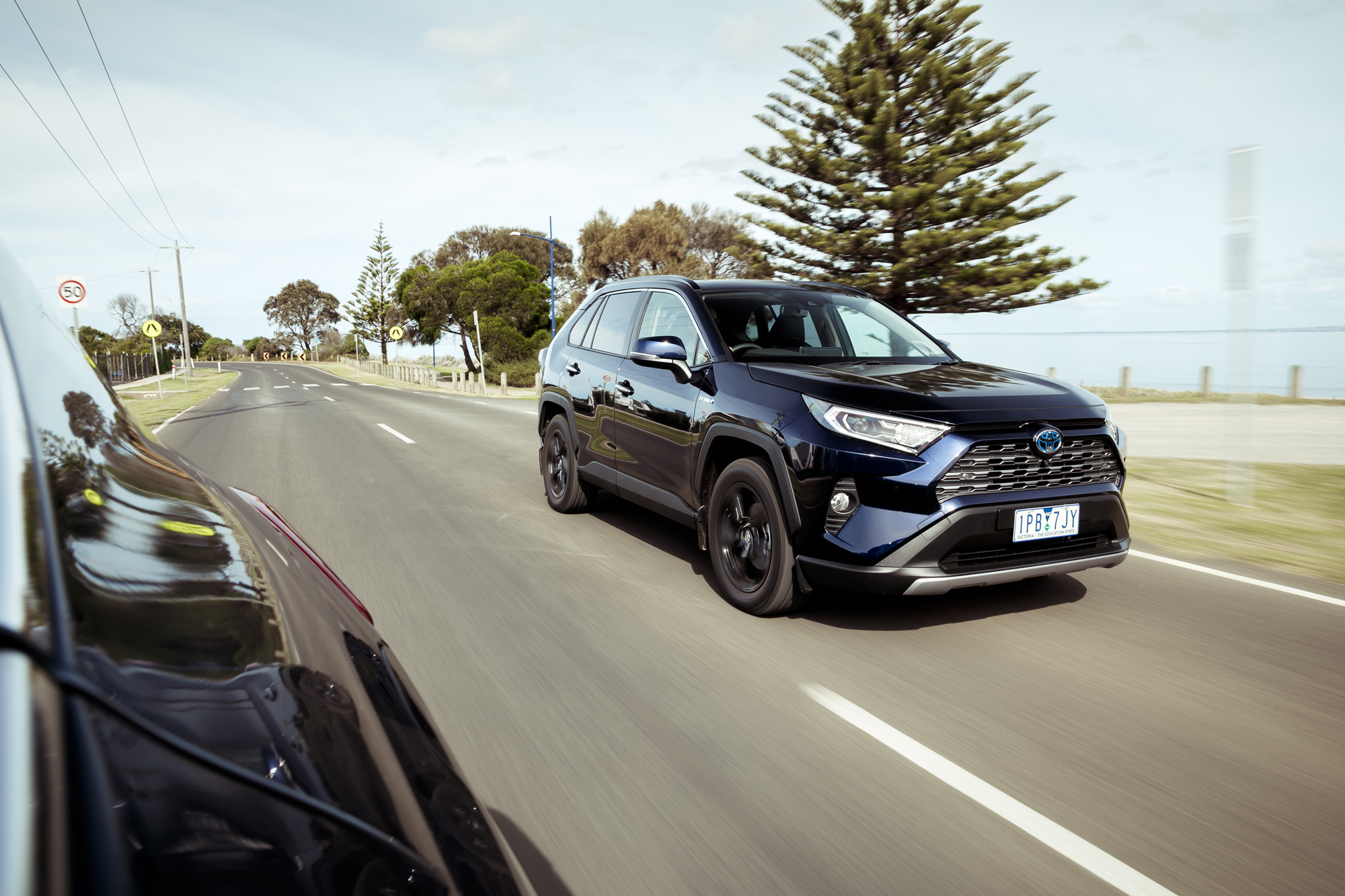
Coming to a boil
That’s why, for the first time in over a decade, a RAV4 wins a Wheels comparison. Not by much, for the Forester’s core attributes – bar-raising comfort, vision, safety and value – remain, but the Toyota hybrid is always close behind in all these and ahead in cargo space while offering palpably better performance and even better fuel economy. When the petrol-electric Subaru arrives, the order may reverse.
For different reasons, a similarly minuscule gap separates the charming Mazda and ripsnorting Volkswagen, but the CX-5 offers greater consistency. The Tiguan soars with searing speed, efficiency and packaging, but prices itself perilously close to luxury alternatives.
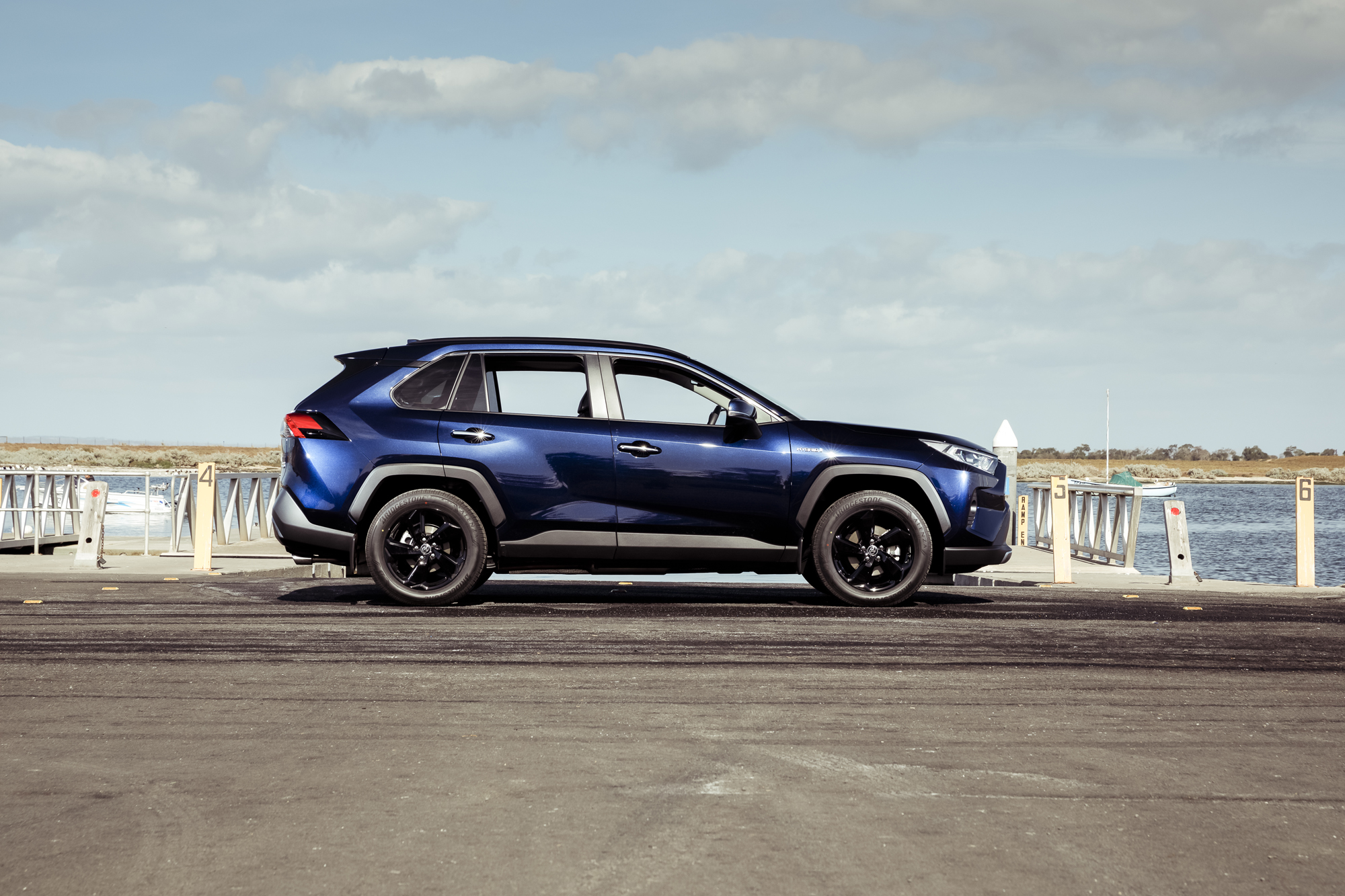
Which leaves the fun and frisky Tucson – still compelling in terms of accommodation and ease of operation, and truly a hoot to hustle hard thanks to self-assured handling. But the Hyundai is getting on, isn’t cheap, and is prone to restlessness and rowdiness. It would rather raise a drink than raise a bar.
That’s now the RAV4’s thing. Toyota has forged ahead in the biggest game in town.
Mid-size SUV specs comparison
TOYOTA RAV4 HYBRID | SUBARU FORESTER 2.5i-S | MAZDA CX-5 GT TURBO | VW TIGUAN 162TSI HIGHLINE | HYUNDAI TUCSON HIGHLANDER | |
Price | $44,640 | $41,490 | $47,890 | $50,150 | $46,500 |
Engine | in-line 4cyl, dohc, 16v + motor | flat 4cyl, dohc, 16v | in-line 4cyl, dohc, 16v, turbo | in-line 4cyl, dohc, 16v, turbo | in-line 4cyl, dohc, 16v, turbo |
Layout | front engine (east-west), all drive | front engine (east-west), all drive | front engine (east-west), all drive | front engine (east-west), all drive | front engine (east-west), all drive |
Capacity | 2487cc | 2498cc | 2488cc | 1984cc | 1591cc |
Power | 163kW (total system output) | 136kW @ 6000rpm | 170kW @ 5000rpm | 162kW @ 6200rpm | 130kW @ 5500rpm |
Torque | 221Nm @ 3600-5200rpm | 239Nm @ 4000rpm | 420Nm @ 2000rpm | 350Nm @ 1500-4400rpm | 265Nm @ 1500-4500rpm |
Trans. | CVT | CVT | 6-speed automatic | 7-speed dual-clutch | 7-speed dual-clutch |
Weight | 1745kg | 1617kg | 1720kg | 1637kg (tare) | 1666kg |
Boot | 580 litres | 498 litres | 442 litres | 615 litres | 488 litres |
Fuel | 91 octane/55 litres | 91 octane/63 litres | 91 octane/58 litres | 95 octane/60 litres | 91 octane/62 litres |
Economy | 8.7L/100km (test average) | 10.1L/100km (test average) | 11.9L/100km (test average) | 10.7L/100km (test average) | 12.3L/100km (test average) |
ANCAP | Not tested | Five-star | Five-star | Five-star | Five-star |
0-100km/h | 8.0sec | 9.2sec | 7.5sec | 6.6sec | 8.4sec |
80-120km/h | 5.2sec | 5.9sec | 5.3sec | 4.6sec | 6.0sec |
100km/h-0 | 37.6m | 39.5m | 37.3m | 37.7m | 36.1m |
Verdict | 8.5/10 | 8.5/10 | 7.5/10 | 7.5/10 | 7.0/10 |

